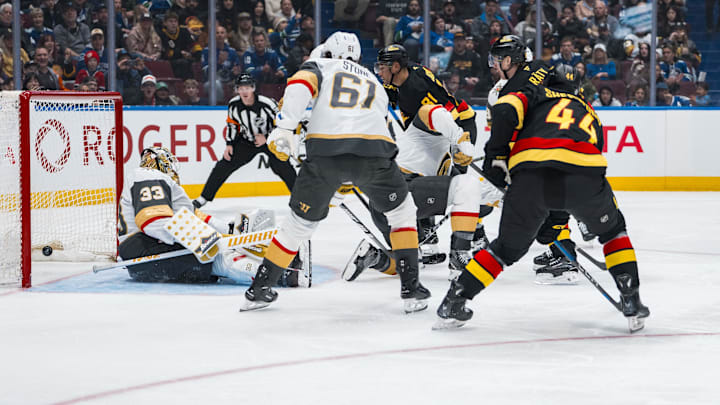Do you know what goaltender interference is? Is it when the hockey player enters the goal crease and makes it impossible for the netminder to make a save?
It seemed that way in the second period when Aatu Raty got his sixth goal of the season. Adin Hill couldn't make a hockey move and move freely in the crease.
So Bruce Cassidy did what every rational head coach does. He challenged the play for goaltender interference. How did Eric Furlatt, NHL referee and future spokesperson for Lasik eye surgery, feel about the call?
Vegas challenges for goaltender interference but is unsuccessful, so Raty's goal counts
— Hockey Daily 365 l NHL Highlights & News (@HockeyDaily365) April 7, 2025
Do you agree? 🤔#VegasBorn | #Canucks pic.twitter.com/fW0w1XynJw
The goal counts and the game's tied, 2-2. Of course, not many Golden Knights fans thought the goal was good. It left them asking one question:
Apparently, Furlatt didn't find conclusive evidence that Hill had time to reset. Vancouver gets a good goal and gets back into the game.
Of course, this wasn't the only questionable call in the game. Mark Stone got away with a tripping call in the third period. Is it a makeup call from the Raty fiasco in the second period? Who knows?
One thing's for certain, though. NHL referees seem to be auditioning for a full-time gig in the NFL these days (at least Eric Furlatt is). But would this "good" goal affect Sunday's outcome? Would the Canucks walk away with two points as a result? Or did the Golden Knights overcome adversity and move further from the Los Angeles Kings in the Pacific Division?
The Vegas Golden Knights defeated the Vancouver Canucks anyways
Thanks to a late Victor Olofsson goal, the Golden Knights edged the Vancouver Canucks, 3-2. Make that five points ahead in the Pacific Division race, with a bad Furlatt call not mattering anyway.
Like Saturday, Sunday wasn't an easy game for the Vegas Golden Knights. Nils Hoglander scored in the first period to kickstart the goal party. But the Golden Knights responded with goals from Ivan Barbashev and Nicolas Roy, giving them a 2-1 lead after one period.
While Furlatt was practicing his best Stevie Wonder impersonation, a big storyline involved the netminders themselves. Kevin Lankinen was solid for the Vancouver Canucks, stopping 32 of 35 shots. Adin Hill kept the Golden Knights in the game, stopping 19 of 21 shots. He even came up with an incredible save shortly after the question Raty goal.
Still, Vegas is playing like they're not in a "one-off," making Bruce Cassidy proud. Dealing with adversity when the sky's falling hardens a team. No matter what circumstances lie, digging deep and winning is what matters. That's what's happening with Vegas as they get closer to clinching the Pacific Division.
Does the NHL know what goaltender interference is?
So what is goaltender interference? Who knows. It's become a definition that even Gary Bettman can't get his finger on.
One can define it as an opposing player making avoidable contact with the goaltender, either inside or outside the crease. Here's how Rule 69.1 of the NHL rulebook says it is:
"This rule is based on the premise that an attacking player's position, whether inside or outside the crease, should not, by itself, determined whether a goal should be disallowed or not. In other words, goals scored while attacking players are standing in the crease may, in appropriate circumstances be allowed."NHL Rulebook (Rule 69.1)
The rules also stipulate that a goal should be disallowed if:
- An attacking player, either by his positioning or by contact, impairs the goaltender's ability to move freely in the crease and defend his goal.
- An attacking player initiates intentional or deliberate contact with a goalkeeper, inside or outside the crease. Incidental contact is permitted IF the attacker makes a reasonable effort to avoid such contact.
The good news? It didn't matter in the end. All that mattered was a grinding win. Separate from a red-hot Los Angeles Kings team (8-2-0 in their last 10 games) and you'll win the division. That's what makes teams like the Golden Knights Stanley Cup contenders.
